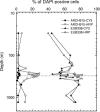Comparison of vertical distributions of prokaryotic assemblages in the anoxic Cariaco Basin and Black Sea by use of fluorescence in situ hybridization
- PMID: 16597973
- PMCID: PMC1449015
- DOI: 10.1128/AEM.72.4.2679-2690.2006
Comparison of vertical distributions of prokaryotic assemblages in the anoxic Cariaco Basin and Black Sea by use of fluorescence in situ hybridization
Abstract
Individual prokaryotic cells from two major anoxic basins, the Cariaco Basin and the Black Sea, were enumerated throughout their water columns using fluorescence in situ hybridization (FISH) with the fluorochrome Cy3 or horseradish peroxidase-modified oligonucleotide probes. For both basins, significant differences in total prokaryotic abundance and phylogenetic composition were observed among oxic, anoxic, and transitional (redoxcline) waters. Epsilon-proteobacteria, Crenarchaeota, and Euryarchaeota were more prevalent in the redoxclines, where previous studies reported high rates of chemoautotrophic production relative to those in waters above and below the redoxclines. Relative abundances of Archaea in both systems varied between 1% and 28% of total prokaryotes, depending on depth. The prokaryotic community composition varied between the two anoxic basins, consistent with distinct geochemical and physical conditions. In the Black Sea, the relative contributions of group I Crenarchaeota (median, 5.5%) to prokaryotic communities were significantly higher (P < 0.001; n = 20) than those of group II Euryarchaeota (median, 2.9%). In contrast, their proportions were nearly equivalent in the Cariaco Basin. Beta-proteobacteria were unexpectedly common throughout the Cariaco Basin's water column, accounting for an average of 47% of 4',6'-diamidino-2-phenylindole (DAPI)-stained cells. This group was below the detection limit (<1%) in the Black Sea samples. Compositional differences between basins may reflect temporal variability in microbial populations and/or systematic differences in environmental conditions and the populations for which they select.
Figures





Similar articles
-
Epsilonproteobacteria represent the major portion of chemoautotrophic bacteria in sulfidic waters of pelagic redoxclines of the Baltic and Black Seas.Appl Environ Microbiol. 2008 Dec;74(24):7546-51. doi: 10.1128/AEM.01186-08. Epub 2008 Oct 24. Appl Environ Microbiol. 2008. PMID: 18952879 Free PMC article.
-
Phylogenetic diversity of bacterial and archaeal communities in the anoxic zone of the Cariaco Basin.Appl Environ Microbiol. 2001 Apr;67(4):1663-74. doi: 10.1128/AEM.67.4.1663-1674.2001. Appl Environ Microbiol. 2001. PMID: 11282619 Free PMC article.
-
Comparison of fluorescently labeled oligonucleotide and polynucleotide probes for the detection of pelagic marine bacteria and archaea.Appl Environ Microbiol. 2002 Feb;68(2):661-7. doi: 10.1128/AEM.68.2.661-667.2002. Appl Environ Microbiol. 2002. PMID: 11823205 Free PMC article.
-
Single-cell identification in microbial communities by improved fluorescence in situ hybridization techniques.Nat Rev Microbiol. 2008 May;6(5):339-48. doi: 10.1038/nrmicro1888. Nat Rev Microbiol. 2008. PMID: 18414500 Review.
-
Microbial ecology of deep-sea hypersaline anoxic basins.FEMS Microbiol Ecol. 2018 Jul 1;94(7). doi: 10.1093/femsec/fiy085. FEMS Microbiol Ecol. 2018. PMID: 29905791 Review.
Cited by
-
Analysis of composition and structure of coastal to mesopelagic bacterioplankton communities in the northern gulf of Mexico.Front Microbiol. 2013 Jan 18;3:438. doi: 10.3389/fmicb.2012.00438. eCollection 2012. Front Microbiol. 2013. PMID: 23346078 Free PMC article.
-
A Dissolved Oxygen Threshold for Shifts in Bacterial Community Structure in a Seasonally Hypoxic Estuary.PLoS One. 2015 Aug 13;10(8):e0135731. doi: 10.1371/journal.pone.0135731. eCollection 2015. PLoS One. 2015. PMID: 26270047 Free PMC article.
-
Symbiont Community Composition in Rimicaris kairei Shrimps from Indian Ocean Vents with Notes on Mineralogy.Appl Environ Microbiol. 2022 Apr 26;88(8):e0018522. doi: 10.1128/aem.00185-22. Epub 2022 Apr 11. Appl Environ Microbiol. 2022. PMID: 35404070 Free PMC article.
-
Metatranscriptomic analyses of plankton communities inhabiting surface and subpycnocline waters of the Chesapeake Bay during oxic-anoxic-oxic transitions.Appl Environ Microbiol. 2014 Jan;80(1):328-38. doi: 10.1128/AEM.02680-13. Epub 2013 Oct 25. Appl Environ Microbiol. 2014. PMID: 24162577 Free PMC article.
-
Protistan microbial observatory in the Cariaco Basin, Caribbean. II. Habitat specialization.ISME J. 2011 Aug;5(8):1357-73. doi: 10.1038/ismej.2011.7. Epub 2011 Mar 10. ISME J. 2011. PMID: 21390077 Free PMC article.
References
-
- Astor, Y., F. Muller-Karger, and M. I. Scranton. 2003. Seasonal and interannual variation in the hydrography of the Cariaco Basin: implications for basin ventilation. Continent. Shelf Res. 23:125-144.
-
- Campbell, B., C. Jeanthon, J. E. Kostka, G. W. I. Luther, and C. S. Cary. 2001. Growth and phylogenetic properties of novel bacteria belonging to the epsilon subdivision of the Proteobacteria enriched from Alvinella pompejana and deep-sea hydrothermal vents. Appl. Environ. Microbiol. 67:4566-4572. - PMC - PubMed
Publication types
MeSH terms
Substances
LinkOut - more resources
Full Text Sources
Molecular Biology Databases

